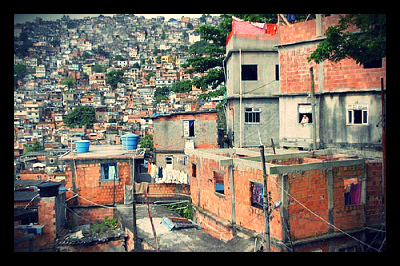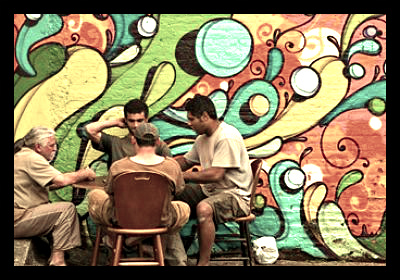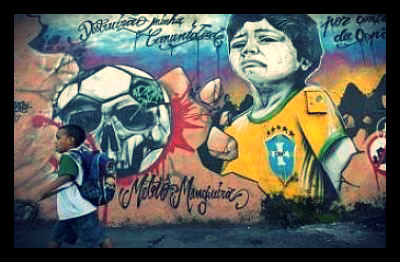Street art can be one of the strongest forms of protest. It has the power to reveal complex issues on any urban surface. It is not afraid to look at themes that are far from beautiful. It touches at the ugly and the unjust. It is omnipresent, shouting its message at passersby as they rush through the streets.
The graceless, ungainly entrance of FIFA’s 2014 World Cup and the 2016 Olympics into the daily fabric of impoverished Brazilians’ lives has projected, on an international scale, the deep-rooted inequalities ailing the giant South American nation. In this climate, several street artists’ images have emerged as honest, indignant reflections of the reality faced by the poorest Brazilians.
Paulo Ito
Paulo Ito’s wailing child with only a soccer ball to eat has quickly gone viral as an anti-FIFA icon since May 10, when the artist painted the image on the doors of a São Paulo schoolhouse. Ito consciously created the work in the Pompeia district, which is mostly a middle class area. In an interview with Slate, Ito discussed the thought that must go into the placement of street art. He initially wanted to create the mural outside of the Itaquerão Stadium that will hold 70,000 soccer fans at the World Cup opener in the second week of June. Yet Ito decided it is best to avoid placing charged images in poverty-stricken areas where people are already so intimately familiar with the reality he seeks to express in his art.
Ito’s piece critiques the state of Brazilian society. Funding for health care, public transportation and education have been crowded out by the billions of dollars the government in Brasilia is pouring into the two mega sporting events. An increase in transportation fares last year was met by massive protests throughout the country’s subways and bus stations. Many Brazilians are furious.
Ito, when asked about his painting, explained “people already have the feeling and that image condensed this feeling…The truth is there is so much wrong in Brazil that it is difficult to know where to start. I didn’t mean [to say] nobody is doing anything against poverty. But we need to show the world or ourselves that the situation is still not good.”
Haas&Hahn
Jeroen Koolhaas and Dre Urhahn (Haas&Hahn) of the Netherlands have been working on their Favela Painting project for close to 10 years. Their goal is to paint an entire favela in Rio de Janeiro in order to shift the discussion of Brazilian favelas from perceptions of danger, crime and poverty, to a discovery of vibrancy, culture and beauty.
The project’s focus, according to the organization’s website, is ”mobilizing people to transform their own communities into social art works of monumental size, to beautify and inspire, combat prejudice and attract positive attention, while offering opportunity and economic stimulus.”
Haas&Hahn began on-the-ground work on the massive project in early 2014. Their plan is to train and hire locals to help with the community project, make repairs to buildings in the favela and develop a local paint factory that will create even more jobs in a sustainable way.
From Paulo Ito to Haas&Hahn, artists are putting street art to good work in Brazil. Through their images they are bluntly pointing out the injustices plaguing Brazilian society and creatively seeking to make Brazil a better, brighter place.
– Kayla Strickland
Sources: Favela Painting, Policy Mic, Slate
Photo: The Slate




